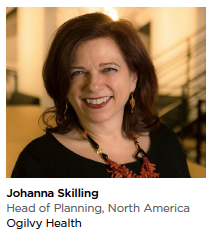 My favorite definition of a brand is the one that goes “a brand is something that lives between your ears." A more tangible description comes from author James Gregory who says, “a brand is the sum total of all the images, ideas, and experiences associated with that brand." So when we ask ourselves what it means to be or become a relevant brand in today’s rapidly changing world, it means thinking through how we want to be perceived in patients’ minds, and fit in with the culture they experience. Here are three thoughts on how to begin.
My favorite definition of a brand is the one that goes “a brand is something that lives between your ears." A more tangible description comes from author James Gregory who says, “a brand is the sum total of all the images, ideas, and experiences associated with that brand." So when we ask ourselves what it means to be or become a relevant brand in today’s rapidly changing world, it means thinking through how we want to be perceived in patients’ minds, and fit in with the culture they experience. Here are three thoughts on how to begin.
1. Embrace the Sheer Simplicity of Consumer-Centricity. Beer marketers hang out in pubs. Airline marketers fly. Fashion marketers shop. So, when was the last time your team sat with people dealing with arthritis? Multiple sclerosis? Any one of the dozens of cancers that affect so many of us? Not in focus groups, those sterile classrooms where responders often believe they’ll be rewarded for good behavior. Not even through ethnographies, where the fear of Heisenberg’s uncertainty principle is always present. But just good old-fashioned … hanging out.
None of us can be in the doctor’s office during an exam. But where can we encounter patients in unguarded moments, when we have the chance to learn something true, something raw, something unexpected? One of the most moving and rewarding experiences I had was at a conference for breast cancer patients and survivors at Memorial Sloan Kettering. I listened to symposia and hallway conversations, all by people talking about their experiences, hopes, and fears. Where can you imagine going to hear people’s unfiltered stories, see their honest expressions, get the smallest true glimpse of how they navigate life with the condition we hope to help them treat?
2. Partner for Purpose. The Association of National Advertisers chose two words for their 2018 word of the year, and those two words were, you guessed it, “brand purpose."1 From Dove’s ongoing campaign to celebrate women’s real beauty, to Gillette’s new spot taking a stand against toxic masculinity, advertisers across the board are aligning themselves with a higher purpose.
And that’s important because, according to the 2018 Edelman Earned Brand study, 64% of consumers around the world will buy or boycott a brand “solely because of its position on a social or political issue," a number that has increased a “staggering" 13 points in a single year.2 Another poll showed that 75% of global consumers expect brands to contribute to their well-being and quality of life.3
But beyond simply showing what you stand for, or even doing things that make a difference for consumers, author Solitaire Townsend has an even more inspiring suggestion: help people help others. A Futerra survey showed that virtually all of us — 96% — believe that what we do can make a difference to the planet and each other.
But here’s the kicker: 88% said they would like brands to help them do more and better. One example is Google’s new database for U.S. veterans to identify jobs based on the skills they learned while in service to the country. Imagine the power that pharma has to not just talk about purpose, but help more people help each other.
3. Accept the Idea that Maybe, Just Maybe, Robots are People Too. You saw it: Super Bowl ads from companies as diverse as Pringles, Michelob, and TurboTax featured robots as characters, alongside their carbon-based counterparts. These spots signal a real change in the culture, where machines know us better, interact with us in ways real humans might, and show up in more everyday forms, like Simplisafe, Google (again), and Alexa (also Super Bowl features).
Ogilvy Health has helped drones deliver medicine in Brazil, created a smart tennis racket to improve your game, and put a voicebot in a giant tooth that resides in your local dentist’s office. But we’re only beginning to tap opportunities to improve peoples’ health, from consumer-facing, AI-powered caregivers, to deeply embedded blockchain-enabled initiatives at every point in drug development and delivery.
But, if we’re to make this happen, we have to acknowledge and help change what Claire Gillis, International CEO, WPP Health Practice, calls the “long-standing taboo around the use of health data."4 In a time when millions gladly pay to give up their DNA to find out if their ancestors are from Scotland or Sardinia, health privacy may no longer be the sacrosanct topic we currently believe it to be.
There is so much more to talk about, and there’s no shortage of work to do. Let’s make our healthcare brands resonate even more strongly with the people they’re meant to help.(PV)
Editor’s Notes: 1 Mandese J. 2018 Marketing Word(s) of the Year: ‘Brand Purpose.’ Marketing Daily. December 6, 2018, https://www.mediapost.com/publications/article/328947/2018-marketing-words-of-the-year-brand-purpose.html. Accessed February 7, 2019. 2 Edelman. Two-Thirds of Consumers Worldwide Now Buy on Beliefs. October 2, 2018. https://www.edelman.com/news-awards/two-thirds-consumers-worldwide-now-buy-beliefs. Accessed February 7, 2019. 3 Wander E. Purpose Matters to Customers. ADWEEK. April 15, 2018. https://www.adweek.com/brand-marketing/infographic-what-consumers-expect-of-brands-when-it-comes-to-issues-they-care-about/. Accessed February 7, 2019. 4 Gillis, C. Are Smart Phones the Gateway to Global Healthcare? THINKWELL, WPP Health. January 2019. http://thinkwellwpphp.com/are-smart-phones-the-gateaway-to-global-healthcare.html. Accessed February 7, 2019.

















